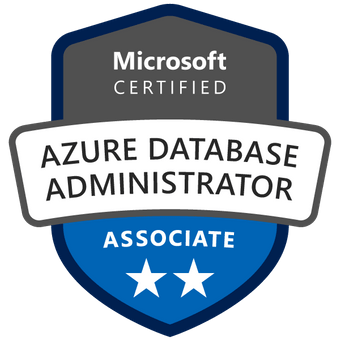
Course Description
This course provides students with the knowledge and skills to administer a SQL Server database infrastructure for cloud, on-premises and hybrid relational databases and who work with the Microsoft PaaS relational database offerings. Additionally, it will be of use to individuals who develop applications that deliver content from SQL-based relational databases.
Who Should Attend?
The audience for this course is data professionals managing data and databases who want to learn about administering the data platform technologies that are available on Microsoft Azure. This course is also valuable for data architects and application developers who need to understand what technologies are available for the data platform with Azure and how to work with those technologies through applications.
About this course
Course Outline
Plan and implement data platform resources (20–25%)
Implement a secure environment (15–20%)
Monitor, configure, and optimize database resources (20–25%)
Configure and manage automation of tasks (15–20%)
Plan and configure a high availability and disaster recovery (HA/DR) environment (20–25%)
Plan and implement data platform resources (20–25%)
Plan and deploy Azure SQL Database solutions
Deploy database offerings on selected platforms
Understand automated deployment
Apply patches and updates for hybrid and infrastructure as a service (IaaS) deployment
Deploy hybrid SQL Server database solutions
Recommend an appropriate database offering based on specific requirements
Evaluate the security aspects of the possible database offering
Recommend a table partitioning solution
Recommend a database sharding solution
Configure resources for scale and performance
Configure Azure SQL Database for scale and performance
Configure Azure SQL Managed Instance for scale and performance
Configure SQL Server on Azure Virtual Machines for scale and performance
Configure table partitioning
Configure data compression
Plan and implement a migration strategy
Evaluate requirements for the migration
Evaluate offline or online migration strategies
Implement an online migration strategy
Implement an offline migration strategy
Perform post migration validations
Troubleshoot a migration
Set up SQL Data Sync for Azure
Implement a migration to Azure
Implement a migration between Azure SQL services
Implement a secure environment (15–20%)
Configure database authentication and authorization
Configure authentication by using Active Directory and Microsoft Azure Active Directory (Azure AD), part of Microsoft Entra
Create users from Azure AD identities
Configure security principals
Configure database and object-level permissions using graphical tools
Apply principle of least privilege for all securables
Troubleshoot authentication and authorization issues
Manage authentication and authorization by using T-SQL
Implement security for data at rest and data in transit
Implement transparent data encryption (TDE)
Implement object-level encryption
Configure server- and database-level firewall rules
Implement Always Encrypted
Configure secure access
Configure Transport Layer Security (TLS)
Implement compliance controls for sensitive data
Apply a data classification strategy
Configure server and database audits
Implement data change tracking
Implement dynamic data masking
Manage database resources by using Azure Purview
Implement Azure SQL Database ledger
Implement row-level security
Configure Microsoft Defender for SQL
Monitor, configure, and optimize database resources (20–25%)
Monitor resource activity and performance
Prepare an operational performance baseline
Determine sources for performance metrics
Interpret performance metrics
Configure and monitor activity and performance
Monitor by using SQL Insights
Monitor by using Extended Events
Monitor and optimize query performance
Configure Query Store
Monitor by using Query Store
Identify sessions that cause blocking
Identify performance issues using dynamic management views (DMVs)
Identify and implement index changes for queries
Recommend query construct modifications based on resource usage
Assess the use of query hints for query performance
Review execution plans
Configure database solutions for optimal performance
Implement index maintenance tasks
Implement statistics maintenance tasks
Implement database integrity checks
Configure database automatic tuning
Configure server settings for performance
Configure Resource Governor for performance
Implement database-scoped configuration
Configure compute and storage resources for scaling
Configure intelligent query processing (IQP)
Configure and manage automation of tasks (15–20%)
Create and manage SQL Server Agent jobs
Manage schedules for regular maintenance jobs
Configure job alerts and notifications
Troubleshoot SQL Server Agent jobs
Automate deployment of database resources
Automate deployment by using Azure Resource Manager templates (ARM templates) and Bicep
Automate deployment by using PowerShell
Automate deployment by using Azure CLI
Monitor and troubleshoot deployments
Create and manage database tasks in Azure
Create and configure elastic jobs
Create and configure database tasks by using automation
Automate database workflows by using Azure Logic Apps
Configure alerts and notifications on database tasks
Troubleshoot automated database tasks
Plan and configure a high availability and disaster recovery (HA/DR) environment (20–25%)
Recommend an HA/DR strategy for database solutions
Recommend HA/DR strategy based on Recovery Point Objective/Recovery Time Objective (RPO/RTO) requirements
Evaluate HA/DR for hybrid deployments
Evaluate Azure-specific HA/DR solutions
Recommend a testing procedure for an HA/DR solution
Plan and perform backup and restore of a database
Recommend a database backup and restore strategy
Perform a database backup by using database tools
Perform a database restore by using database tools
Perform a database restore to a point in time
Configure long-term backup retention
Backup and restore a database by using T-SQL
Backup and restore to and from cloud storage
Configure HA/DR for database solutions
Configure active geo-replication
Configure an Always On availability group
Configure auto-failover groups
Configure quorum options for a Windows Server Failover Cluster
Configure failover cluster instances on Azure Virtual Machines
Configure log shipping
Monitor an HA/DR solution
Troubleshoot an HA/DR solution
Prerequisites
Successful Azure Database Administrators start this role with professional experience in database management and technical knowledge of cloud technologies.
Specifically:
Working with, maintaining, and developing with SQL Server
Experience with Azure, such as deploying and managing resources
At a minimum, you should know the information in the following online training before attending the course:
AZ-900 Azure Fundamentals
DP-900 Azure Data Fundamentals
Where
This will be a virtual event hosted on Microsoft Teams. In the Microsoft Teams platform and sessions, your name, email address, or title may be viewable by other participants. By joining this event, you agree to this experience.
